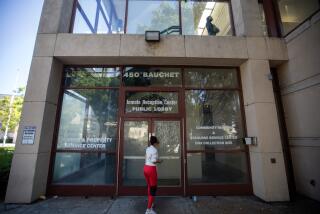Radioactive Gas Leak Traced to Overloaded Chemical Tank
- Share via
WEBBERS FALLS, Okla. — A chemical tank at a nuclear facility was overloaded when it cracked, causing a leak of 14 1/2 tons of radioactive gas that killed one man and injured dozens of others who breathed the potent acid fumes, authorities said Sunday.
The accident on Saturday at the Sequoyah Fuels Corp. uranium fuel processing plant sent more than 100 people to hospitals seeking treatment for acid exposure and forced the closing of nearby Interstate 40 for two hours.
The plant remained closed Sunday, and 26 of those hospitalized overnight were released. Eight persons remained hospitalized in stable or good condition.
Improperly Placed on Scale
The release of uranium hexafluoride apparently occurred after a cylinder was accidentally overloaded, Dick Bangart, director of the Division of Radiation Safety and Safeguards for the Nuclear Regulatory Commission, told a news conference in Muskogee.
The cylinder, designed to hold 27,500 pounds of the mildly radioactive material, was filled with 29,500 pounds before workers realized that they had improperly placed it on a scale, he said.
Workers heated the cylinder in an attempt to remove the excess gas, Bangart said. The container then ruptured.
The employee who died was on a platform above the cylinder and downwind of the poison plume, Bangart said.
The facility, which is a subsidiary of Kerr-McGee Corp. of Oklahoma City, will not resume uranium processing until the NRC and other agencies, including Kerr-McGee, complete their investigation, Kerr-McGee officials said.
‘No Evidence’ of Exposure
“We have absolutely no evidence of radioactive exposure,” said Dr. Michael Herndon, an emergency room physician at Sequoyah Memorial Hospital in Sallisaw.
Uranium hexafluoride produced at the plant, 40 miles from the Arkansas border, is sent to a facility operated by the Energy Department, where it is enriched by increasing the percentage of fissionable isotopes.
Authorities said the gas cloud dissipated in 20-m.p.h. wind about two hours after the leak was reported.
Dale McHard, chief of the radiation and special hazards service of the state Department of Health, said soil and vegetation samples indicated that the acid cloud may have traveled as far as 18 miles south of the plant before it dispersed. He said that effects were expected to be temporary.
More to Read
Sign up for Essential California
The most important California stories and recommendations in your inbox every morning.
You may occasionally receive promotional content from the Los Angeles Times.












